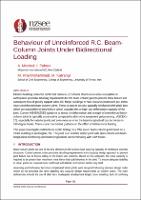Behaviour of Unreinforced R.C. Beam-Column Joints Under Bidirectional Loading

Download
Date
2023-04-19Authors
Moshref, Amir
Khanmohammadi, Mohammad
Palmer, Isaac
Metadata
Show full item recordAbstract
Modern building codes for reinforced concrete (RC) frame structures in areas susceptible to earthquakes prescribe detailing requirements for the beam-column joint to prevent shear failure and subsequent loss of gravity support. Most RC frame buildings in New Zealand constructed pre-1960s have unreinforced beam-column joints. Additionally, these structures are typically reinforced with plain bars which are susceptible to bond failure which degrades the strength and deformation capacity of the joint. Current MBIE/NZSEE guidance to assess the deformation and strength of unreinforced beam-column joints is typically conservative compared to alternative assessment guidance (e.g., ASCE41-17), especially for exterior joints and even more so when the beam longitudinal bars terminate in 180º hooks. It also has limited guidance on the effect of bidirectional loading.
This paper investigates bidirectional cyclic testing on a 70% scaled beam-column joint based on a 1930s building in Wellington, NZ. The joint is an exterior corner joint with plain column and beam longitudinal reinforcing and beam longitudinal bars terminating with 180º hooks.
